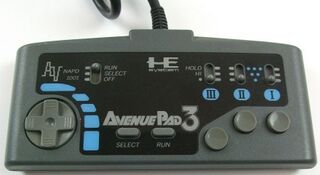Difference between revisions of "Avenue Pad 3"
From NEC Retro
m (Text replacement - "==Physical Scans==" to "==Physical scans==") |
m (Text replacement - "type=Controller" to "type=Control pad") |
||
| (One intermediate revision by the same user not shown) | |||
| Line 4: | Line 4: | ||
| title= | | title= | ||
| maker=[[NEC Avenue]] | | maker=[[NEC Avenue]] | ||
| + | | type=Control pad | ||
| madefor=[[PC Engine]] | | madefor=[[PC Engine]] | ||
| releases={{releasesPCE | | releases={{releasesPCE | ||
Latest revision as of 13:46, 24 June 2023

| ||||||||||
| Avenue Pad 3 | ||||||||||
|---|---|---|---|---|---|---|---|---|---|---|
| Made for: PC Engine | ||||||||||
| Manufacturer: NEC Avenue | ||||||||||
| Type: Control pad | ||||||||||
|
The Avenue Pad 3 (アベニューパッド3) is an officially licensed three button controller for the PC Engine released by NEC Avenue in 1991. It was initially sold by itself, but was later packaged with Forgotten Worlds as part of a special bundle.
It adds a third fire button (Ⅲ) in addition to the standard Ⅰ and Ⅱ buttons. Unlike the later Avenue Pad 6, the added button doesn't provide any unique functionality of its own but simply duplicates the effect of the SELECT or RUN keys, which is assigned through a switch. This made the controller suitable for action games which had special moves or such assigned to either button such as Shinobi, Bloody Wolf and Akumajou Dracula X: Chi no Rondo, as well as the aforementioned Forgotten Worlds. There are also turbo switches for each fire button, although the turbo switch for button Ⅲ works a bit differently, as it has a "hi" setting for turbofire and a "hold" setting for autofire, whereas the other two switches simply have two turbo settings.
The PC Blaster later released by Sur De Wave provided functionalities similar to the Avenue Pad 3.
Physical scans
| PC Engine |
|---|
| PC Engine (1987) | CoreGrafx (1989) | CoreGrafx II (1991) X1 Twin (1987) | PC-KD863G (1988) | Shuttle (1989) | GT (1990) | LT (1991) |
| Add-Ons |
| AV Booster (1988) | Interface Unit (1988) | Ten no Koe 2 (1989) | Backup Booster (1989) | Backup Booster II (1989) | Ten no Koe Bank (1991) | Memory Base 128 (1993) |

